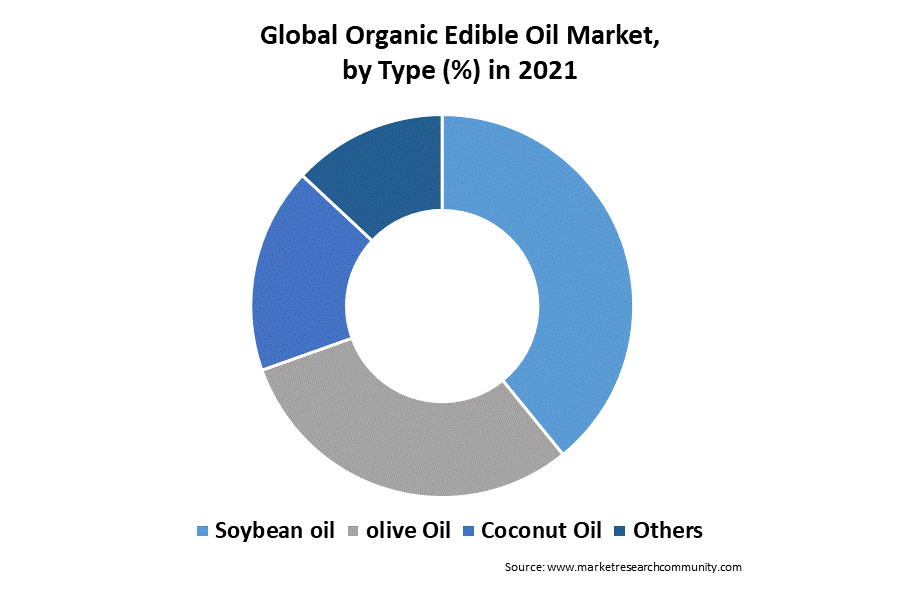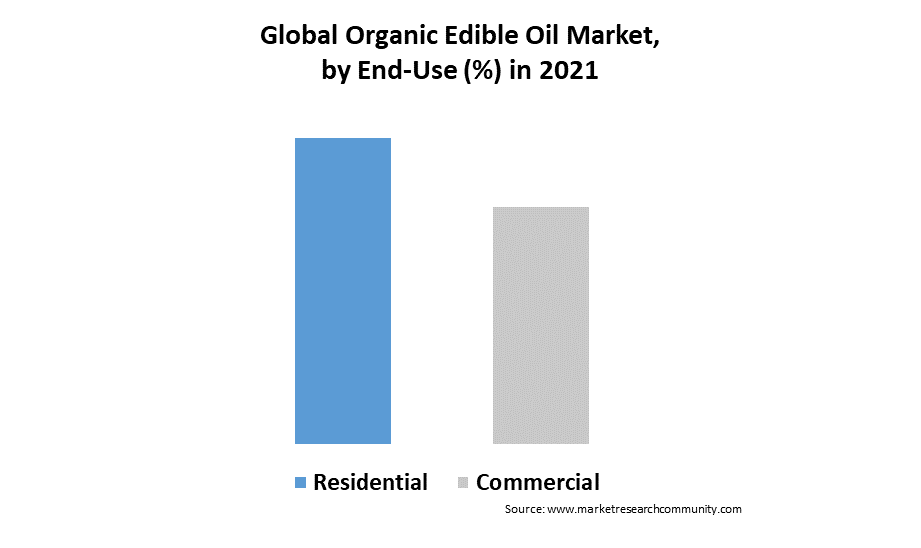Organic Edible Oil Market Insights
Organic Edible Oil Market size is projected to be worth USD 171.7 Billion by 2028, registering a CAGR of 7.3% during the forecast period (2024-2028), the market was valued at USD 95.7 Billion in 2024. Soybean oil exhibit a clear dominance in the type segment as the large amount of soybean crop produced, organic soybean oil is the most widely consumed oil on the planet. Supermarkets and hypermarkets are expected to dominate the market due to increased consumer reliance on such stores for grocery shopping as a result of attractive shelf arrangements, discount offers, and home delivery services.
Organic edible oil is derived from plants or herbs that were grown or processed in accordance with organic principles. The manufacturing process eliminates the need for synthetic substances, which improves the quality of organic oil. Organic oil’s market is driven by consumer awareness of its health benefits. It is widely used in the beauty and cosmetic industries. Oils are high in essential fatty acids, which are beneficial for maintaining skin function, making skin healthier, and treating a variety of problems.
Organic Edible Oil Market Dynamics
Driver:
The growing demand for organic edible oil due to rising consumer health concerns, which is propelling the edible oil market forward. Further, rising demand for edible oils with low calorie, cholesterol, and fat content is estimated to lift the growth of the market.
Restraints:
The processing cost of edible oil has been a restraining factor in the edible oils market. As a result, the price of edible oil rises in general, and consumers are less likely to buy it when compared to other edible oils. This is more visible in low-income regions than in developed regions.
Opportunity:
The growing use of edible oil in pharmaceuticals, as well as increased public initiatives related to health and fitness, are driving the market forward. Consumer awareness of the health benefits of edible oil is increasing the pressure on market players to innovate in order to stay competitive. Further, consumer awareness in terms of numerous benefits associated with edible oil’s in cosmetics and personal care sectors. is driving the demand. Moreover, due to rise in Internet culture, it is now easier to find information on homemade remedies for skin conditions and personal care. As a result, for homemade personal care products, consumers are turning to medicinally beneficial oils such as olive oil and walnut oil. This factor is primarily responsible for the increase in demand for native edible oil.
COVID-19 Impact Analysis:
The growing popularity of healthy foods among consumers, organic edible oil market is expected to enhance during the COVID-19 pandemic. Organic edible oil is widely used in cooking, which may increase its demand. Despite the pandemic, the food and beverage industry expanded. Furthermore, the use of e-commerce websites is expected to increase sales of organic edible oil. As a result, these factors have the potential to boost market growth during the pandemic.
Organic Edible Oil Market Report Coverage
| Report Attributes | Report Details |
| Study Timeline | 2016-2028 |
| Market Size in 2028 (USD Billion) | 171.7 |
| CAGR (2024-2028) | 7.3% |
| By Mode | Soybean Oil, Olive Oil, Coconut Oil, Others |
| By End-Use | Residential, Commercial |
| By Distribution Channel | Supermarkets/Hypermarkets, Online Retail Stores, Specialty Stores, Others |
| By geography | North America: U.S., Canada, Mexico
Europe: Germany, France, U.K., Russia, Italy, Spain, BENELUX, Rest of Europe Asia Pacific: China, Japan, India, South Korea, Australia, ASEAN, Rest of Asia Pacific Latin America: Brazil, Argentina, Chile, Rest of Latin America The Middle East and Africa: GCC, Turkey, Israel, Rest of MEA |
Organic Edible Oil Market Segmental Analysis:
By Type
The type segment is divided into soybean oil, olive oil, coconut oil, and others. Soybean oil exhibit a clear dominance in the market as they provide several benefits over other types of organic edible oil. As, the large amount of soybean crop produced, organic soybean oil is the most widely consumed oil on the planet. The widespread availability of the raw material, soybean, is expected to enhance product growth. Organic soybean oil’s high emulsification and lubrication properties are expected to boost product sales.

End-Use
The End-Use segment is categorized into residential and commercial. Residential customers dominate the market as organic oil is lower in fat than regular oil. As the population of obese and diabetic patients grows, so does the consumption of low-fat foods. Customers are more interested in healthy food products as they are concerned about their physical appearance and health. This factor is estimated to fuel the growth of the organic edible oil market.

By Distribution Channel
By distribution channel segment is categorized into supermarkets/hypermarkets, online retail stores, specialty stores, and others. Supermarkets and hypermarkets are expected to dominate the global organic edible oil market. The increased consumer reliance on such stores for grocery shopping as these stores are convenient, is expected to increase product sales.
By Region
The region segment is divided into Asia Pacific, Europe, North America, Middle East and Africa, Latin America. North America market is expected to account for the largest revenue share in the global market over the forecast period. The factors responsible for the growth are increasing adoption of edible oil in the cosmetic industry. The Asia Pacific market is expected to grow faster in the coming years. The factors driving the growth of the edible oils market in the region are a growing population, rising disposable income, presence of key manufacturer. Further, increased awareness among individuals about the health benefits of edible oil usage have significantly boosted the demand of organic edible oil market.
Organic Edible Oil Market Competitive Landscape:
The competitive landscape of the market has been analyzed in the report, along with the detailed profiles of the major players operating in the industry. Further, surge in Research and Development (R&D), product innovation, and various business strategies have accelerated the growth of the market. Some of these players in Organic Edible Oil Market are:
Key Players
- Cargill, Incorporated
- ACH Food Companies, Inc.
- Bunge Limited
- ADM
- Adani Group
- American Vegetable Oils, Inc.
- BORGES INTERNATIONAL GROUP, S.L.
- Hebany Group
- NGO CHEW HONG EDIBLE OIL PTE LTD
- Ragasa – Derechos Reservados
- SOVENA
- Sunora Foods
Recent Development:
- December 2024, to reduce India’s reliance on other countries for palm oil and lower import costs India intends to significantly increase its palm oil production. India increased its palm oil production in northeast, where weather conditions are favorable. The government is investing USD 1.5 billion over the next five years to expand palm oil plantations by 6500 square kilometers across the country.
- In November 2024, Cargill purchased an edible oil refinery in Nellore, Andhra Pradesh. In order to meet growing customer demand Cargill’s invested in acquiring and upgrading the production facility.
FAQ
What is the size of Organic Edible Oil Market?
The size of Organic Edible Oil Market is USD 171.7 Billion by 2028.
Who are the major players operating in this industry?
Cargill, Incorporated, ACH Food Companies, Inc., Bunge Limited, ADM, Adani Group are the major players operating in this industry.
Which region contributed the largest share of the market growth?
North America is expected to contributed the largest share of the market growth.
What is the main market-driving factor?
The growing demand for organic edible oil due to rising consumer health concerns.
Which is the leading type segment in this market?
Soybean Oil are anticipated to contribute the largest share to the type segment.
Table of Content
- Introduction
- Market Introduction
- Market Research Methodology
- Research Process
- Primary Research
- Secondary Research
- Data Collection Technique
- Data Sources
- Market Estimation Methodology
- Limitations of the Study
- Product Picture of Organic Edible Oil
- Global Organic Edible Oil Market: Classification
- Geographic Scope
- Years Considered for the Study
- Research Methodology in brief:
- Parent Market Overview
- Overall Organic Edible Oil Market Regional Demand
- Research Programs/Design
- Market Breakdown and Data Triangulation Approach
- Data Source
- Secondary Sources
- Primary Sources
- Primary Interviews:
- Average primary breakdown ratio
- Market Dynamics
- Drivers
- Drivers
- Restraints
- Opportunity
- Impact forces on market dynamics
- Impact forces during the forecast years
- Industry Value Chain
- Upstream analysis
- Downstream analysis
- Distribution Channel
- Direct Channel
- Indirect Channel
- Potential Customers
- Manufacturing/Operational Cost Analysis
- Pricing Analysis by Region
- Key Technology Landscape
- Regulatory Analysis
- Porter’s Analysis
- Supplier Power
- Buyer Power
- Substitution Threat
- Threat from New Entry
- Competitive Rivalry
- PESTEL Analysis
- Political Factors
- Economic Factor
- Social Factors
- Technological Factor
- Environmental Factors
- Legal Factor
- Covid-19 impact on Global Economy
- Covid-19 impact on Organic Edible Oil demand
- Post-Covid Impact on Organic Edible Oil Market Demand
- Impact Analysis of Russia-Ukraine Conflict
- Drivers
- Global Organic Edible Oil Market Segmentation, by Volume (Kilo Tons) & Revenue (USD Billion), (2022-2030)
- By Mode
- Soybean Oil
- Olive Oil
- Coconut Oil
- Others
- By Distribution Channel
- Supermarkets/Hypermarkets
- Online Retail Stores
- Specialty Stores
- Others
- By End Use
- Residential
- Commercial
- By Mode
- Global Organic Edible Oil Market Overview, By Region
- North America Organic Edible Oil Market Volume (Kilo Tons) & Revenue (USD Billion), by Countries, (2022-2030)
- US
- By Mode
- By Distribution Type
- By End Use
- Canada
- Mexico
- US
- Europe Organic Edible Oil Market Volume (Kilo Tons) & Revenue (USD Billion), by Countries, (2022-2030)
- France
- UK
- Spain
- Russia
- Italy
- BENELUX
- Asia Pacific Organic Edible Oil Market Volume (Kilo Tons) & Revenue (USD Billion), by Countries, (2022-2030)
- China
- Japan
- Australia
- South Korea
- India
- ASEAN
- North America Organic Edible Oil Market Volume (Kilo Tons) & Revenue (USD Billion), by Countries, (2022-2030)
- Latin America Organic Edible Oil Market Volume (Kilo Tons) & Revenue (USD Billion), by Countries, (2022-2030)
- Brazil
- Argentina
- Chile
- Middle East and Africa Organic Edible Oil Market Volume (Kilo Tons) & Revenue (USD Billion), by Countries, (2022-2030)
- GCC
- Turkey
- South Africa
- Global Organic Edible Oil Market Revenue: Competitive Analysis, 2021
- Key strategies by players
- Revenue (USD Billion and %), By manufacturers, 2021
- Player Positioning by Market Players, 2021
- Competitive Analysis
- Cargill, Incorporated
- Business Overview
- Business Financials (USD Million)
- Product Category, Type, and Specification
- Main Business/Business Overview
- Geographical Analysis
- Recent Development
- Swot Analysis
- ACH Food Companies, Inc.
- Bunge Limited
- ADM
- Adani Group
- American Vegetable Oils, Inc.
- BORGES INTERNATIONAL GROUP, S.L.
- Hebany Group
- NGO CHEW HONG EDIBLE OIL PTE LTD
- Ragasa – Derechos Reservados
- SOVENA
- Sunora Foods
- Cargill, Incorporated
- Market Research Findings & Conclusion
Disclaimer
Research Methodology
The Market Research Community offers numerous solutions and its full addition in the research methods to be skilled at each step. We use wide-ranging resources to produce the best outcome for our customers. The achievement of a research development is completely reliant on the research methods implemented by the company. We always faithful to our clients to find opportunities by examining the global market and offering economic insights.Market Research Community are proud of our widespread coverage that encompasses the understanding of numerous major industry domains. Company offers consistency in our research report, we also offers on the part of the analysis of forecast across a range of coverage geographies and coverage. The research teams carry out primary and secondary research to carry out and design the data collection methods.
